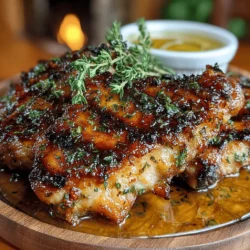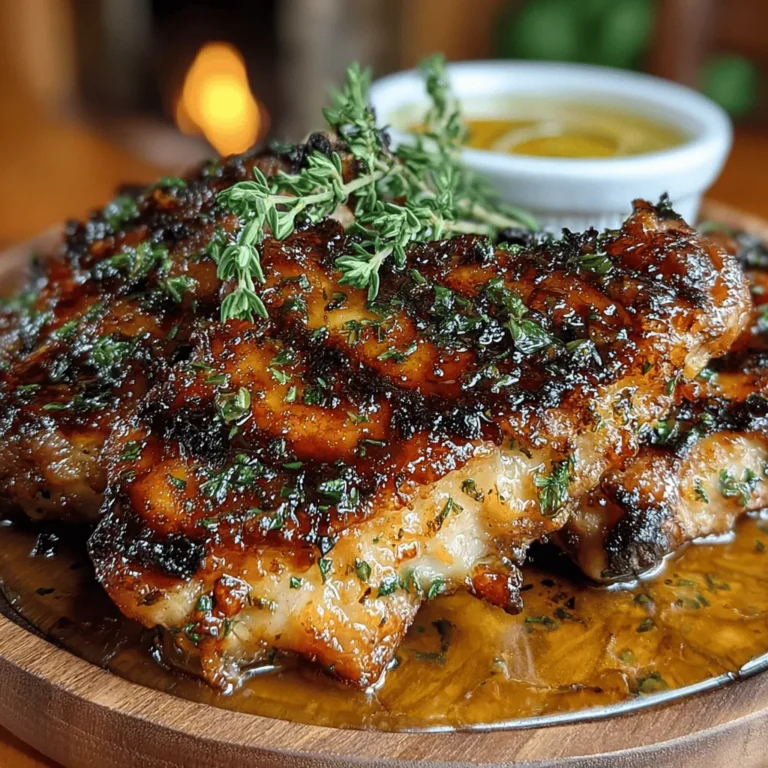Introduction
The aroma of roasted turkey legs wafting through the kitchen is a comforting reminder of family gatherings and festive occasions. This Maple Glazed Roasted Turkey Legs recipe combines the rich flavors of maple syrup, soy sauce, and spices to create a dish that is not only delicious but also visually appealing. Perfect for any special occasion or a cozy weeknight dinner, this recipe is easy to follow and guarantees moist, tender turkey legs with a sweet and savory glaze.
The Allure of Maple Glazed Roasted Turkey Legs
Turkey legs, often a staple at holiday feasts and outdoor barbecues, have garnered a reputation for being hearty and flavorful. Unlike turkey breasts, which can sometimes be dry and bland, turkey legs are abundant in dark meat, making them a favorite for those who enjoy a richer taste. The meat is succulent and falls off the bone when cooked correctly, providing the perfect canvas for a robust glaze.
Maple syrup, a quintessentially North American ingredient, is not just for pancakes and waffles. Its natural sweetness brings a unique dimension to savory dishes, balancing the saltiness of soy sauce and enhancing the overall flavor profile. The combination of sweet and savory is a hallmark of many successful recipes, and this dish exemplifies that principle beautifully. The maple glaze caramelizes during roasting, creating a glossy finish that not only looks appealing but also tantalizes the taste buds.
Roasted turkey has deep roots in culinary traditions, particularly in North America, where it takes center stage during Thanksgiving celebrations. However, turkey is versatile enough to be enjoyed year-round. By incorporating a maple glaze, this recipe elevates the humble turkey leg to a dish worthy of any gathering, whether it be a holiday feast, a backyard barbecue, or a cozy family dinner.
Ingredients Breakdown
To create the perfect Maple Glazed Roasted Turkey Legs, gathering the right ingredients is essential. The following components will not only contribute to the dish’s flavor but also ensure a delightful cooking experience.
– Turkey Legs: Choosing the right cut is crucial for achieving the best results. Look for fresh, high-quality turkey legs that are plump and well-trimmed. Organic or locally sourced options are often more flavorful and can enhance the overall dish.
– Pure Maple Syrup: The importance of quality cannot be overstated when it comes to maple syrup. Opt for pure maple syrup rather than imitation varieties, as the latter often contains artificial flavors and sweeteners that can detract from the dish’s authenticity. Pure maple syrup provides a rich, complex sweetness that is essential for the glaze.
– Soy Sauce: This ingredient plays a pivotal role in enhancing umami flavors. The saltiness of soy sauce complements the sweetness of the maple syrup, creating a balanced marinade. For a gluten-free option, tamari can be used as a substitute.
– Dijon Mustard and Spices: Adding depth to the marinade is essential for a well-rounded flavor. Dijon mustard contributes a tangy note that cuts through the sweetness, while spices such as garlic powder, onion powder, and black pepper add layers of flavor.
– Olive Oil: The role of fat in cooking cannot be overlooked. Olive oil not only helps to keep the turkey legs moist during roasting but also aids in the caramelization process, resulting in a beautifully golden-brown exterior.
Preparation Process
Creating a flavorful marinade is a key step in this recipe, and it’s easier than you might think. Here’s a step-by-step guide to mixing the marinade ingredients and ensuring that your turkey legs are infused with flavor.
1. Mix the Marinade: In a large mixing bowl, combine 1/2 cup of pure maple syrup, 1/4 cup of soy sauce, 2 tablespoons of Dijon mustard, 2 tablespoons of olive oil, and your selected spices. Whisk the ingredients together until they are well-blended, ensuring that the maple syrup and soy sauce are fully incorporated.
2. Marinate the Turkey Legs: Place the turkey legs in a large resealable plastic bag or a shallow dish. Pour the marinade over the turkey legs, making sure they are evenly coated. Seal the bag or cover the dish with plastic wrap, and refrigerate for at least 4 hours. For optimal flavor infusion, marinating overnight is recommended. This allows the flavors to penetrate the meat, resulting in a juicier and more flavorful dish.
3. Bring to Room Temperature: Before cooking, remove the turkey legs from the refrigerator and let them sit at room temperature for about 30 minutes. This step ensures even cooking and helps to prevent the meat from becoming tough.
The Cooking Method
Preheating the oven is crucial for optimal roasting. Proper temperature control is vital to ensure that the turkey legs cook evenly and develop a crispy, caramelized exterior. Begin by preheating your oven to 375°F (190°C). This moderate temperature allows the turkey legs to cook through without burning the glaze.
Once the oven is preheated, transfer the marinated turkey legs to a roasting pan, arranging them in a single layer. Make sure to reserve the leftover marinade for basting later. Place the roasting pan in the oven and let the turkey legs roast for approximately 45 minutes to 1 hour, or until they reach an internal temperature of 165°F (74°C). Basting the turkey legs with the reserved marinade every 15-20 minutes will help to intensify the flavors and keep the meat moist.
As the turkey legs roast, the kitchen will fill with the enticing scent of maple and spices, setting the stage for a delicious meal that’s about to be enjoyed. Stay tuned for the next part of this article, where we will delve into the finishing touches and serving suggestions for your Maple Glazed Roasted Turkey Legs.
{{image_2}}
Searing the Turkey Legs
Searing turkey legs is a crucial step in achieving a beautifully golden-brown crust that not only enhances the visual appeal of your dish but also adds a rich depth of flavor. To achieve this, follow these techniques:
1. Preheat Your Pan: Begin by heating a large, heavy skillet over medium-high heat. A hot pan is essential for a good sear, as it creates a Maillard reaction that develops flavor.
2. Pat Dry: Ensure your turkey legs are dry by patting them with paper towels. Moisture can prevent a proper sear, leading to steaming rather than browning.
3. Use Oil: Add a small amount of oil (such as vegetable or canola) to the pan, just enough to coat the surface. This will help in achieving that desired crust.
4. Don’t Overcrowd: Add the turkey legs to the pan in batches if necessary. Overcrowding the pan can lower the temperature, leading to inadequate browning.
5. Sear Each Side: Allow the turkey legs to sear without moving them for about 4-5 minutes on each side, or until a deep golden-brown color forms. This step locks in the juices and enhances the flavor.
Benefits of Searing Before Roasting
Searing turkey legs before roasting offers several benefits:
– Flavor Development: The browning process creates additional layers of flavor that enhance the overall taste of the turkey.
– Texture Improvement: A good sear provides a crispy exterior that contrasts nicely with the tender meat inside.
– Juiciness: Searing helps to seal the juices within the meat, resulting in a more succulent turkey leg once it’s roasted.
Roasting the Turkey Legs
After searing, it’s time to roast your turkey legs to perfection. Follow these steps to ensure a juicy and flavorful result:
1. Preheat the Oven: Set your oven to 375°F (190°C) before placing the turkey legs inside. A consistent temperature is crucial for even cooking.
2. Place in Roasting Pan: Transfer the seared turkey legs to a roasting pan. If you have any remaining marinade, you can pour it over the legs for added flavor.
3. Insert a Meat Thermometer: The importance of using a meat thermometer cannot be overstated. Insert it into the thickest part of the leg, avoiding the bone. The turkey is safe to eat once it reaches an internal temperature of 165°F (74°C).
4. Basting for Flavor: Every 30 minutes, baste the turkey legs with the drippings from the pan or additional marinade. This not only keeps the meat moist but also intensifies the glaze’s flavors as it cooks.
5. Cook Time: Roast the turkey legs for approximately 1.5 to 2 hours, or until the meat thermometer reads 165°F (74°C). Cooking times may vary based on the size of the legs.
Creating the Glaze
Transforming the marinade into a glaze is the final step that elevates your turkey legs to a new level of flavor. Here’s how to do it:
1. Strain the Marinade: Once the turkey legs are done roasting, remove the pan from the oven and strain the remaining marinade into a saucepan. This ensures a smooth glaze, free from any bits of herbs or solids.
2. Reduction Process: Bring the strained marinade to a boil over medium heat. Then, reduce to a simmer and allow it to reduce by half. This concentration process intensifies the flavors, creating a rich glaze.
3. Balancing Flavors: Taste the glaze and adjust as necessary. If it’s too sweet, add a splash of vinegar or lemon juice to balance the flavor. If it’s too tangy, a bit more maple syrup can help sweeten it.
4. Finish with Butter: For a glossy and rich finish, whisk in a tablespoon of butter at the end of the reduction process. This adds a luxurious mouthfeel to the glaze.
Serving Suggestions
Presentation plays a key role in making your Maple Glazed Roasted Turkey Legs shine. Here are some ideas to beautifully serve this dish:
Garnishing with Fresh Thyme
Fresh herbs can elevate the presentation of your turkey legs. Consider garnishing with sprigs of fresh thyme or rosemary. Not only does this add color, but it also introduces an aromatic element to the dish.
Pairing Suggestions
To complement the flavors of the maple glaze, consider serving your turkey legs with the following side dishes:
– Roasted Vegetables: A medley of seasonal roasted vegetables such as carrots, Brussels sprouts, and sweet potatoes can enhance the meal’s rustic feel.
– Mashed Potatoes: Creamy mashed potatoes provide a perfect base for soaking up the delicious glaze.
– Cranberry Sauce: The tartness of cranberry sauce contrasts beautifully with the sweetness of the maple glaze, creating a harmonious balance.
– Stuffing or Dressing: A savory stuffing made with herbs and bread is a classic pairing that rounds out the meal.
Nutritional Information
Understanding the nutritional value of your Maple Glazed Roasted Turkey Legs can help you enjoy this dish guilt-free. Here’s a breakdown of the approximate nutritional content per serving (one turkey leg):
– Calories: 350
– Total Fat: 20g
– Saturated Fat: 6g
– Cholesterol: 150mg
– Sodium: 800mg
– Total Carbohydrates: 15g
– Dietary Fiber: 0g
– Sugars: 10g
– Protein: 30g
Health Benefits of Key Ingredients
– Turkey: A lean source of protein, turkey is low in fat and provides essential nutrients like B vitamins and selenium.
– Maple Syrup: While it adds sweetness, maple syrup also contains antioxidants and minerals like manganese and zinc.
– Thyme: This herb is rich in vitamins A and C, as well as antioxidants, contributing to overall health.
Conclusion
Maple Glazed Roasted Turkey Legs is a delightful recipe that not only satisfies the palate but also brings warmth and joy to any dining table. With its simple preparation and rich flavors, this dish is sure to become a favorite in your culinary repertoire. Whether for a holiday feast or a casual dinner, these turkey legs will impress guests and family alike, making each meal a memorable occasion.
Try this recipe for your next gathering, and enjoy the compliments that come your way! With a little effort and attention to detail, you can create a stunning dish that showcases the delicious combination of maple sweetness and savory turkey flavors.


